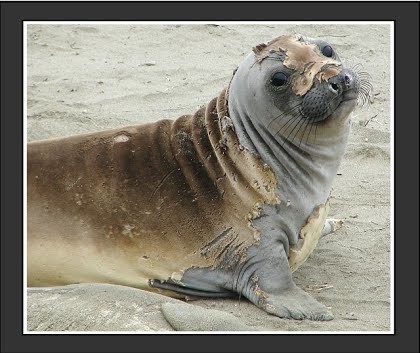Molting in elephant seals
Never be cavalier about what you think you know about nature. A few weeks ago, when we were overseas, we were looking through a photo book of friends who had visited the West coast. I was browsing the captions written in Hebrew and I understood one of them to say that elephant seals molt once a year. Now, between the fact that my Hebrew is not perfect and English is not their native tongue, I was amused because mammals do not molt. And I said so. Big mistake. To be fair, I went back to my computer to check this out, and discovered that not only do elephant seal molt once a year, but it is such a complete and major process, with their losing all of the old fur and epidermal skin, that it is called a catastrophic molt. Needless to say, I was embarrassed, but it was an opportunity to learn something interesting.
The molting process lasts 25 to 28 days, during which time the animals do not feed, since they do not go into the water. It occurs on a different schedule depending on age and gender. Females and juvenile animals will molt in April to May. May through June is for sub-adult males, and the adult males molt from July through August. Molting is accompanied by fasting. However, there is a second 25 to 28 day period when these seals fast, and that is during the birthing and mating period. All other times of the year, the seals are far offshore feeding. Between birthing/mating and the molt, they are in the general
California area, although they can range thousands of miles offshore.
Elephant seals get their name because of the pendulous nose structure – or proboscis – of the males. This feature does not develop until the males start becoming sexually mature, which happens when they are between 3 and 5 years old. This nasal structure is involved in the mating “dance,” in that in order to establish dominance, males will inflate the nose and produce a noise that sounds like a drum. This warns less dominant males away.
Northern elephant seals are a conservation success story. They were once slaughtered wholesale for their blubber - which the animals need for storing energy, insulation against the cold and buoyancy-- which was rendered into oil for the production of soap, margarine, cosmetics and oil-burning lamps. By 1892, the population had plummeted from hundreds of thousands to fewer than 120 animals. In 1922, the Mexican government--since they were found in Guadalupe Island off Baja--designated them a protected species. As they increased in numbers and moved north into American California, the U.S. government introduced protective measures as well. Today, the population is estimated at 160,000 animals.
If there are Northern Elephant seals, then it is not surprising that there are Southern Elephant Seals. The southern animals are found in Antarctic and sub-Antarctic waters feeding on the rich marine life that thrives in those waters. The northern seals, meanwhile, after mating will move north to feed in the waters off northern Washington State and Vancouver Island, British Columbia.
Hard as it may be to imagine, elephant seals spend the bulk of their lives in the water. The Northern females come ashore to give birth to their young in December, usually just one pup, which weighs about 75 pounds at birth and will grow to between 250 to 350 pounds in the 25 to 28 days that the mother will nurse the pup. She will wean the pup by returning to the water and the pup will learn on its own how to swim and hunt.
The females are receptive to the males about 24 days after giving birth. The fertilized egg, however, remains in a state known as delayed implantation, during which the embryo does not implant in the uterus but instead, remains in a state of dormancy for several months. Other animals that employ this gestational method include bear, kangaroos, weasels and badgers.
Classically, molting refers to the process whereby skin, the pelage – hair, feather, fur or wool – or some body part is shed. Dog owners find more hair shed as the cold months resolve, and birds change their plumage. Sometimes we find an empty snakeskin in the garden, and apparently lizards, frogs and salamanders shed skin as well. I am more familiar with insect molting as the insect grows larger and needs to shed its exoskeleton (outer skeleton). Most impressively, butterflies change from wormlike caterpillars to the beautiful creatures whose body parts have no identifiable relation to those of the caterpillar.
So this week, a misconception turned into a major learning experience for me.






